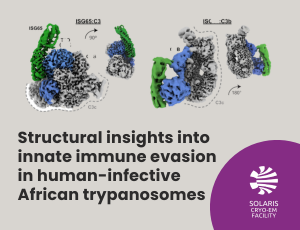
 Web Content Display
Web Content Display
SOLARIS centre
 Web Content Display
Web Content Display
 Web Content Display
Web Content Display
Structural insights into innate immune evasion in human-infective African trypanosomes

Researchers from Sebastian Zoll's group at IOCB Prague determined the cryo-EM structures of a surface protein that helps human-infective trypanosomes to evade the alternative pathway of the innate immune response.
Researchers from the Institute of Organic Chemistry and Biochemistry of the Czech Academy of Sciences in Prague have made a significant breakthrough in understanding how the parasite Trypanosoma brucei gambiense, which causes African sleeping sickness, evades the human innate immune system. A new study published in Nature Communications has revealed the structure of the parasite's invariant surface glycoprotein 65 (ISG65) in complex with human complement factors C3 and C3b, key components of the innate immune system. This new insight could lead to the development of new treatments for African sleeping sickness, which affects thousands of people in sub-Saharan Africa. The disease can be fatal if left untreated, and currently there are no effective vaccines or drugs available. One of the ways the parasite is able to efficiently evade the host’s immune system is by expressing a dense surface layer of variant surface glycoproteins (VSGs) that undergo constant antigenic variation, preventing the host from mounting a long-lasting immune response. However, another class of surface proteins, the invariant surface glycoproteins (ISGs), remain relatively constant and do not trigger immune detection of the parasite. The biology of these proteins remains poorly understood, but they are believed to play a crucial role in the parasite's ability to evade the immune system.
In this study, researchers used cryo-electron microscopy (cryo-EM) at SOLARIS to capture detailed images of ISG65 bound to human complement C3 and C3b (Figure 1). They found that ISG65 is able to specifically inhibit the C5 convertase of the alternative complement pathway, thereby preventing the immune system from attacking the parasite at an early stage of infection.
The findings of this study provide new insights into how trypanosomes interact with host factors in the bloodstream, adding another layer of complexity to our understanding of these parasites.
Figure 1. Cryo-EM structures of T. b. gambiense ISG65 in complex with native C3 and C3b.
Cryo-EM density maps showing side views of ISG65:C3 (left), and ISG65:C3b (right) at two different angles. ISG65 is represented by map regions coloured in green. Interacting domains in C3 and C3b are depicted in blue. In both C3 conformations, TED provides the primary interface. ISG65 and TED show a high degree of shape complementarity. Smaller, secondary interfaces are located in ANA (native C3) and CUB (C3b). The remaining scaffold (C3c, grey) shows no additional contact points.
Written by: Sebastian Zoll
The publication can be found here:
H. Sülzen et al., Cryo-EM structures of Trypanosoma brucei gambiense ISG65 with human complement C3 and C3b and their roles in alternative pathway restriction, Nature Communications, 14 (1), 2403(2023) doi: 10.1038/s41467-023-37988-7
